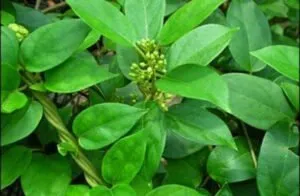On This Page
Mesasringi–Gymnema sylvestre
Introduction
Mesasringi, commonly known as Periploca of the woods is a large woody climber seen through out India. The fruits of the plant resembles that of horns of goat and hence given the name. It is also known as Ajasringi due to the resemblance.
Dr. Gupta’s Institute of Applied Food Allergy, shortlyknown as IAFA, has been consistently working on Mesasringi to find out more medicinal properties of the plant. Our experts have successfully proven the activities like Antidiabetic, Antiviral, Appetizer, Digestive , anti-inflammatory, antimicrobial, digestant, and insecticidal properties of Mesasringi. The plant can be used to treat diseases like Diabetes, Inflammation , Skin disorders, Worm infestations, Cough, Itching, Fever etc. The ethanolic extracts of the plant have excellent anti-inflammatory properties. It helps to alleviate edematous conditions. The extracts have also found to have analgesic activities. Our experts have also proven the Antipyretic activity of the plant.
Action of Mesasringi – Gymnema sylvestre in Allergies
Our IAFA experts have successfully proven the antiallergic, antimicrobial and anti-inflammatory properties of the plant Mesasringi. The plant contains phytoconstituents like gymnamine, alananine, valine, adenine, betaine, nonacosane and these helps in it’s antiallergic action. Decoction prepared from Mesasringi can be used to treat skin allergic conditions and worm infestations.
Vernacular Names
| Native Names | |
| Sanskrit Name | Mesasringi,Ajasringi, Vishani |
| Hindi Name | Gurmar |
| English Name | Periploca of the woods |
| Malayalam Name | Madhunasini |
| Kannada Name | Madhunasini |
| Marathi Name | Bedaki |
Botanical Name
Gymnema sylvestre
Family
Asclepiadaceae
Morphology of Mesasringi – Gymnema sylvestre
- Large woody climber
- Young stems are pubescent
- Leaves are opposite
- Flowers are yellow
- Fruits are follicles
Ayurveda reference of Mesasringi – Gymnema sylvestre

Geographical distribution of Mesasringi – Gymnema sylvestre
Mesasringi seen in South Indian states like Karnataka, Kerala, Tamilnadu & Andhra Pradesh also in West Bengal, Uttar Pradesh.
Phytoconstituents of Mesasringi – Gymnema sylvestre
It contains phytoconstituents like gymnamine, alananine,valine, adenine, betaine, nonacosane etc.
Parts used of Mesasringi – Gymnema sylvestre
- Leaves
- Root
Dosage of Mesasringi – Gymnema sylvestre
- Powder (churna)- 2 g
- Decoction (kwatha) – 60 ml
Medicinal Properties of Mesasringi – Gymnema sylvestre
- Kushtaghna-alleviate skin disorders
- Krimighna – useful in worm infestations
- Kandughan- relieves itching
- Vishaghna – useful in poisoning
- Kasa hara – relieves cough
- Sulahara-relieves pain
- Sophahara – relieves swelling
- Swasahara – relieves asthma .

Have A Health Issue?
Consult Online
- Dr. Sahil Gupta (B.A.M.S., M.H.A.)
Ayurvedic Allergy Specialist
CEO & Founder of IAFA®
Home remedies of Mesasringi – Gymnema sylvestre
Ayurveda is an ancient treatment system which ispurely based on naturally available herbs and materials for the purpose of alleviating diseases. The herbs used in Ayurvedic treatments are toxic free andhave no side effects at all. Mesasringi is one of the most commonly available herb and can be used to treat diseases like –
- In Diabetes (Prameha) – Powder of dried leaves of mesasringi is given in diabetic condition
- In inflammatory conditions (sotha)-Leaf paste of mesasringi is applied over the joint.
- In Fever (Jwara) – 5-7 leaves of mesasringi are collected and made into decoction by adding 4 times water. It is then taken orally.
- In Colic pain (Sula) –mesasringi along with Zingiber officinale is made into decoction. Drinking this decoction at a dose of 60 ml can cure colic pain
- In vomiting (Chardi) – mesasringi is consumed along with ghee, honey and sugar. It can immediately alleviate vomiting
- In Cough (Kasa) – 6-7 leaves of mesasringi is taken and powdered well. It is then taken along with Solanum xanthocarpum and honey.
- In Worm infestation (Krimi roga) – Decoction prepared by crushing root of mesasringi is taken along with Goat’s urine.
- In obesity (sthoulya) – Decoction made with mesasringi and Phyllanthus emblica is taken internally at a dose of 60 ml.
IAFA, guided by Dr.Gupta mainly aims in promotion of Ayurvedic science . We use naturally available herbs to cure diseases especially allergic conditions. IAFA follows guidelines that are purely based on Ayurveda textbooks for treatment purposes. By consistently hard working, we are able to provide you risk free medicines.
Reach IAFA for safe herbal remedies for all your ailments!!!
Was this Page Helpful?
Read More Articles

Daruharidra (Berberis aristata)
Explore the uses, benefits, and medicinal properties of Daruharidra (Berberis aristata), also…

Haridra (Curcuma longa)
Discover the uses, benefits, and medicinal properties of Haridra (Curcuma longa), also…

Bhumi Amla (Phyllanthus Niruri)
Know the Uses, Benefits and Medicinal Properties of Bhumi Amla (Phyllanthus Niruri).…









